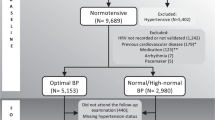Abstract
Cardiac autonomic dysfunction is associated with increased cardiovascular mortality. No data on sympathovagal balance are available in patients with Cushing’s syndrome, in whom cardiovascular risk is high. We studied 10 patients with newly diagnosed Cushing’s syndrome (1 male/9 females; age mean±SD, 47±10 yr) and 10 control subjects matched for age, sex, body mass index, and cardiovascular risk factors. In both groups there were 7 patients with arterial hypertension, 3 with diabetes mellitus, and 2 with obesity. Cardiac autonomic function was evaluated by analysis of short-time heart rate variability (HRV) measures in frequency domain over 24-h, daytime, and nighttime. The 24-h ambulatory blood pressure monitoring and echocardiography were also performed. In comparison with controls, patients with Cushing’s syndrome had lower 24-h (1.3±0.6 vs 3.7±1.5, mean±SD, p<0.01), daytime (2.0±1.4 vs 4.5±1.6, p<0.01), and night-time (1.0±0.4 vs 3.5±2.3, p<0.01) low-frequency/high frequency (LF/HF) power ratio. In the presence of similar LF power, the difference was due to elevation in HF power in Cushing’s syndrome compared to controls: 24-h, 12.7±6.7 vs 5.8±2.8, p<0.01; daytime, 10.2±7.3 vs 4.5±2.1, p<0.05; nighttime, 14.2±7.0 vs 7.8±4.7, p<0.05. Eight Cushing patients vs 4 controls had a non-dipping blood pressure profile. At echocardiography, Cushing patients had a greater left ventricular mass index and/or relative wall thickness, and impaired diastolic function, compared with controls. Compared to controls, patients with Cushing’s syndrome showed a sympathovagal imbalance, characterized by a relatively increased parasympathetic activity. Whether this autonomic alteration is meant to counterbalance cortisol-induced effects on blood pressure and cardiac structure/function or has a different pathophysiological significance is still unknown.
Similar content being viewed by others
References
Task Force of the European Society of Cardiology and the North American Society of Pacing and Electrophysiology. Heart rate variability: standards of measurement, physiological interpretation and clinical use. Circulation 1996, 93: 1043–65.
Tsuji H, Larson MG, Venditti FJ Jr, et al. Impact of reduced heart rate variability on risk for cardiac events. The Framingham Heart Study. Circulation 1996, 94: 2850–5.
Bigger JT Jr, Fleiss JL, Steinman RC, Rolnitzky LM, Kleiger RE, Rottman JN. Correlations among time and frequency domain measures of heart rate variability two weeks after myocardial infarction. Am J Cardiol 1992, 69: 891–8.
Nolan J, Flapan AD, Goodfiels NE, et al. Measurement of parasympathetic activity from-24-hour ambulatory electrocardiograms and its reproducibility and sensitivity in normal subjects, patients with symptomatic myocardial ischemia, and patients with diabetes mellitus. Am J Cardiol 1996, 77: 154–8.
Kohara K, Hara-Nakamura N, Hiwada K. Left ventricular mass index negatively correlates with heart rate variability in essential hypertension. Am J Hypertens 1995, 8: 183–8.
Burger AJ, Charlamb M, Sherman HB. Circadian patterns of heart rate variability in normals, chronic stable angina and diabetes mellitus. Int JCardiol 1999, 71: 41–8.
Staessen JA, Thijs L, Fagard R, et al. Predicting cardiovascular risk using conventional vs ambulatory blood pressure in older patients with systolic hypertension: Systolic Hypertension in Europe Trial Investigators. JAMA 1999, 282: 539–46.
Kikuya M, Hozawa A, Ohokubo T, et al. Prognostic significance of blood pressure and heart rate variabilities: the Ohasama study. Hypertension 2000, 36: 901–6.
Metoki H, Ohkubo T, Kikuya M, et al. Prognostic significance for stroke of a morning pressure surge and a nocturnal blood pressure decline: the Ohasama Study. Hypertension 2006, 47: 149–54.
Parati G. Blood pressure variability: its measurement and significance in hypertension. J Hypertens 2005, 23: S19–25.
Verdecchia P, Porcellati C, Schillaci G, et al. Ambulatory blood pressure. An independent predictor of prognosis in essential hypertension. Hypertension 1994, 24: 793–801.
Cuspidi C, Macca G, Sampieri L, et al. Target organ damage and non-dipping pattern defined by two sessions of ambulatory blood pressure monitoring in recently diagnosed essential hypertensive patients. J Hypertens 2001, 19: 1539–45.
Whitworth JA, Schyvens CG, Zhang Y, Mangos GJ, Kelly JJ. Glucocorticoid-induced hypertension: from mouse to man. Clin Exp Pharmacol Physiol 2001, 28: 993–996.
Walker BR. Glucocorticoids and cardiovascular disease. Eur J Endocrinol 2007, 157: 545–59.
Lindholm J, Juul S, Jørgensen JOL, et al. Incidence and late prognosis of Cushing’s syndrome: a population-based study. J Clin Endocrinol Metab 2001, 86: 117–23.
Pivonello R, Faggiano A, Lombardi G, Colao A. The metabolic syndrome and the cardiovascular risk in Cushing’s syndrome. Endocrinol Metab Clin N Am 2005, 34: 327–39.
Imai Y, Abe K, Sasaki S, et al. Altered circadian blood pressure rhythm in patients with Cushing’s syndrome. Hypertension 1988, 12: 11–9.
Zelinka T, Strauch B, Pecen L, Widimsky J. Diurnal blood pressure variation in phechromocytoma, primary aldosteronism and Cushing’s syndrome. J Hum Hypertens 2004, 18: 107–11.
Fallo F, Budano S, Sonino N, Muiesan ML, Agabiti-Rosei E, Boscaro M. Left ventricular structural characteristics in Cushing’s syndrome. J Hum Hypertens 1994, 8: 509–13.
Muiesan ML, Lupia M, Salvetti M, et al. Left ventricular structural and functional characteristics in Cushing’s syndrome. J Am Coll Cardiol 2003, 41: 2275–9.
Boscaro M, Barzon L, Fallo F, Sonino N. Cushing’s sindrome. Lancet 2001, 357: 783–91.
Fallo F, Paoletta A, Tona F, Boscaro M, Sonino N. Response of hypertension to conventional antihypertensive treatment and/or steroidogenesis inhibitors in Cushing’s sindrome. J Intern Med 1993, 234: 595–8.
O’Brien E, Sheridan J, O’Malley K. Dippers and non-dippers. Lancet 1988, 2: 397.
Della Mea P, Lupia M, Bandolin V, et al. Adiponectin, insulin resistance, and left ventricular structure in dipper and nondipper essential hypertensive patients. Am J Hypertens 2005, 18: 30–5.
Sahn DJ, DeMaria A, Kisslo J, Weyman A. Recommendations regarding quantitation in M-mode echocardiography: results of a survey of echocardiographic measurements. Circulation 1978, 58: 1072–83.
Ganau A, Devereux RB, Roman MJ, et al. Patterns of left ventricular hypertrophy and geometric remodelling in arterial hypertension. J Am Coll Cardiol 1992, 19: 1550–8.
Devereux RB, Alonso DR, Lutas EM, et al. Echocardiographic assessment on left ventricular hypertrophy: comparison to necropsy findings. Am J Cardiol 1986, 57: 450–8.
de Simone G, Daniels SR, Devereux RB, et al. Left ventricular mass and body size in normotensive children and adults: assessment of allometric relations and of the impact of overweight. J Am Coll Cardiol 1992, 20: 1251–60.
Palatini P, Longo D, Zaetta V, Perkovic D, Garbelotto R, Pessina AC. Evolution of blood pressure and cholesterol in stage 1 hypertension: role of autonomic nervous system activity. J Hypertens 2006, 24: 1375–81.
Ziegler D, Zentai C, Perz S, et al; KORA Study Group. Selective contribution of diabetes and other cardiovascular risk factors to cardiac autonomic dysfunction in the general population. Exp Clin Endocrinol Diabetes 2006, 114: 153–9.
Rabbia F, Silke B, Conterno A, et al. Assesment of cardiac autonomic modulation during adolescent obesity. Obes Res 2003, 11: 541–8.
Whitworth JA, Mangos GJ, Kelly JJ. Cushing, cortisol, and cardiovascular disease. Hypertension 2000, 36: 912–6.
Nonell A, Bodenseh S, Lederebogen F, et al. Chronic but not acute hydrocortisone treatment shifts the response to an orthostatic challenge towards parasympathetic activity. Neuroendocrinology 2005, 81: 63–8.
Bellavere F, Balzani I, De Masi G, et al. Power spectral analysis of heart rate variations improves the assessment of diabetic cardiac autonomic neuropathy. Diabetes 1992, 41: 633–40.
Resmini E, Casu M, Patrone V, et al. Sympathovagal imbalance in acromegalic patients. J Clin Endocrinol Metab 2006, 91: 115–20.
Galetta F, Franzoni F, Fallahi P, et al. Changes in heart rate variability and QT dispersion in patients with overt hypothyroidism. EurJ Endocrinol 2008, 158: 85–90.
Kohara K, Nishida W, Maguchi M, Hiwada K. Autonomic nervous function in non-dipper essential hypertensive subjects. Evaluation by power spectral analysis of heart rate variability. Hypertension 1995, 26: 808–14.
Fouad FM, Tarazi RC, Ferrario CM, Fighaly S, Alicandri C. Assessment of parasympathetic control of heart rate by a noninvasive method. Am J Physiol 1984, 246 (pt 2): H838–42.
Alter P, Grimm W, Vollrath A, Czerny F, Maisch B. Heart rate variability in patients with cardiac hypertrophy-relation to left ventricular mass and etiology. Am Heart J 2006, 151: 829–36.
Mureddu GF, de Simone G, Greco R, Rosato GF, Contaldo F. Left ventricular filling in arterial hypertension. Influence of obesity and hemodynamic and structural confounders. Hypertension 1997, 29: 544–50.
Author information
Authors and Affiliations
Corresponding author
Rights and permissions
About this article
Cite this article
Fallo, F., Maffei, P., Pozza, A.D. et al. Cardiovascular autonomic function in Cushing’s syndrome. J Endocrinol Invest 32, 41–45 (2009). https://doi.org/10.1007/BF03345677
Accepted:
Published:
Issue Date:
DOI: https://doi.org/10.1007/BF03345677




